Hives, also known as urticaria, are red, itchy welts that appear on the skin due to an allergic reaction. These welts can be triggered by various factors such as certain foods, medications, insect bites, or even stress.
For those experiencing hives, relief is often sought through over-the-counter (OTC) antihistamines, which are commonly used to manage the symptoms. Antihistamines work by blocking histamine, the chemical in the body that causes allergy symptoms like itching, swelling, and redness.
Recommended Reading: Food Allergy Treatment At Home (Causes, Symptoms, And Treatment)
Over The Counter Antihistamine For Hives (Causes And Symptoms)

Table Of Contents
Recommended Reading: Is Hay Fever Contagious? Causes, Symptoms, And Treatment
What Are Hives?
Hives, medically known as urticaria, are red, swollen, and itchy welts that form on the skin. These raised patches can be different in size and may appear on different areas of the body.
Hives are usually a result of an allergic reaction or other triggers, causing the release of histamine in the skin. They can last from a few hours to several days and may come and go quickly.
Hives Treatment Option (Urticaria Treatment)
Urticaria Treatment (Hives)
Hives (Urticaria) treatment options include antihistamines, corticosteroids, and avoiding triggers to reduce symptoms like itching and swelling.

Recommended Reading: Natural Allergy Remedies For Eyes (Without Eye Drops)
Antihistamines
Antihistamines are the main treatment for hives and help block the histamine response in your body, which causes itching and swelling.
- Loratadine (Claritin, Alavert): A non-drowsy antihistamine taken orally that helps reduce hives symptoms.
- Cetirizine (Zyrtec Allergy): Another non-drowsy oral antihistamine effective in relieving itching and swelling.
- Diphenhydramine (Benadryl): An oral antihistamine that may cause drowsiness but is useful for reducing allergic reactions.
Cold Compresses
- Applying cold compresses to affected areas can help soothe the skin, reduce swelling, and prevent itching. This can bring quick relief.
Cool Baths
- Taking cool baths can help calm itching and reduce the urge to scratch. Adding colloidal oatmeal can enhance its soothing effect.
Loose Clothing
- Wearing loose-fitting, breathable clothing can prevent further irritation and reduce the discomfort caused by tight clothes rubbing against hives.
Topical Creams
- Applying hydrocortisone or antihistamine creams directly to the affected skin can help reduce redness, itching, and swelling on the surface.
Oral Steroids
- If antihistamines don’t fully relieve the symptoms, oral steroids may be prescribed by a doctor to help control more severe reactions.
Avoid Triggers
- It’s essential to identify and avoid any known triggers like certain foods, medications, or environmental factors to prevent hives flare-ups.
Over The Counter Antihistamine For Hives
OTC Antihistamine For Hives Relief
Over-the-counter antihistamines for hives help relieve itching, swelling, and irritation by blocking the effects of histamine released during allergic reactions.
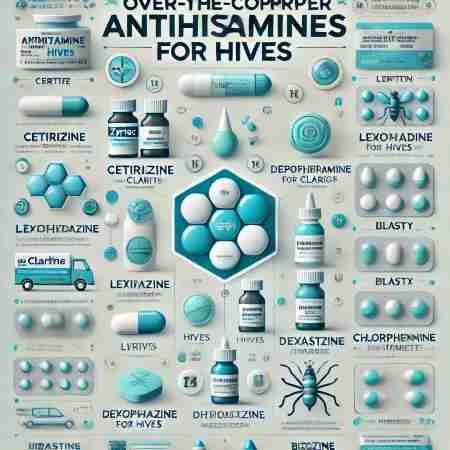
| Antihistamine | Details |
|---|---|
| Cetirizine (Zyrtec) | A non-drowsy antihistamine that helps relieve itching and swelling caused by hives. Usually taken once daily. |
| Loratadine (Claritin) | Another non-drowsy option, ideal for treating chronic hives. Effective in reducing allergic symptoms. |
| Diphenhydramine (Benadryl) | A sedating antihistamine that works quickly to reduce hives but may cause drowsiness, is often used for more severe reactions. |
| Fexofenadine (Allegra) | A fast-acting, non-drowsy antihistamine that helps with chronic hives by reducing itching and inflammation. |
| Levocetirizine (Xyzal) | Known for its potent antihistamine effects, it’s used for treating both acute and chronic hives. |
| Desloratadine (Clarinex) | An extended-release antihistamine that provides 24-hour relief from hives and allergy symptoms without causing drowsiness. |
| Hydroxyzine (Atarax) | A sedative antihistamine used for severe itching and hives, often prescribed when non-drowsy antihistamines aren’t effective. |
| Chlorpheniramine (Chlor-Trimeton) | Older antihistamine that can cause drowsiness but is effective for treating hives symptoms quickly. |
| Rupatadine | A dual-action antihistamine that works on both histamine and PAF receptors, helping to reduce inflammation and itching from hives. |
| Ebastine | A long-acting antihistamine, usually taken once daily, is effective in reducing symptoms of chronic hives without sedation. |
| Bilastine | A newer antihistamine that provides fast relief for itching and swelling without causing drowsiness, typically taken once a day. |
| Mizolastine | An antihistamine known for its rapid onset of action, helpful in managing the symptoms of hives efficiently. |
Recommended Reading: Best Medicine For Runny Nose And Sneezing (Causes And Treatment)
Natural Antihistamine for Hives Treatment
Natural Antihistamine for Hives Relief
Natural antihistamines for hives treatment, like quercetin and vitamin C, help reduce allergy symptoms by blocking histamine release and soothing irritation.

| Natural Antihistamine | Details |
|---|---|
| Oatmeal Baths | Soaking in a cool bath with uncooked oatmeal can help soothe itching and pain caused by hives. |
| Aloe Vera Lotion | Applying aloe vera to affected areas helps reduce itching and provides vitamin E to support skin health. |
| Apple Cider Vinegar | Mixing equal parts apple cider vinegar and water, then applying with a cotton ball, may provide relief from hives. |
| Quercetin | A natural plant compound found in apples, onions, and berries, which may help reduce allergy symptoms like hives. |
| Vitamin C | Known for its immune-boosting effects, Vitamin C may also help relieve hives symptoms by reducing inflammation. |
| Vitamin D | Some studies suggest that Vitamin D supplements can help improve skin health and reduce the occurrence of hives. |
| Fish Oil | Omega-3 fatty acids in fish oil can help reduce inflammation and may ease the severity of hives. |
| Probiotics | A healthy balance of gut bacteria through probiotics may help reduce hives and other allergy-related symptoms. |
| Calamine Lotion | Applying calamine lotion can provide immediate relief from itching and discomfort associated with hives. |
| Cold Compresses | Applying a cool compress on hives can help reduce swelling and itching naturally. |
| Green Tea | Contains natural antioxidants and antihistamine properties that may help reduce hives symptoms and soothe skin. |
| Chamomile Tea | Known for its anti-inflammatory properties, drinking or applying chamomile may help calm irritated skin. |
Recommended Reading: Allergy Medicine For Kids: Types, Uses, And Side Effects
Best Tablets For Hives Treatment
| Tablet Name | Details | Drowsiness | Usage |
|---|---|---|---|
| Loratadine (Claritin) | A non-drowsy antihistamine that reduces itching and swelling caused by hives. | Non-drowsy | Daytime use |
| Cetirizine (Zyrtec) | A popular antihistamine is effective in controlling hives symptoms like itching and swelling. | Slight drowsiness | Daytime or evening use |
| Fexofenadine (Allegra) | Fast-acting, non-drowsy antihistamine, often recommended for long-lasting relief from hives. | Non-drowsy | Daytime use |
| Levocetirizine (Xyzal) | Reduces allergic reactions and treats hives symptoms with minimal drowsiness. | Slight drowsiness | Evening use |
| Diphenhydramine (Benadryl) | A strong antihistamine used to relieve severe itching, often used at night due to its drowsiness effect. | Drowsy | Nighttime use |
| Desloratadine (Clarinex) | A prescription antihistamine for treating severe cases of hives. | Non-drowsy | Doctor-prescribed for severe cases |
| Hydroxyzine (Vistaril) | A potent antihistamine used to treat more severe allergic reactions, including chronic hives. | Drowsy | Doctor-prescribed for severe cases |
| Cimetidine (Tagamet) | An H2 blocker that may be used alongside antihistamines to reduce hives symptoms. | Non-drowsy | Doctor-prescribed for combination use |
| Famotidine (Pepcid) | Another H2 blocker is sometimes used in combination with antihistamines for treating hives. | Non-drowsy | Doctor-prescribed for combination use |
| Montelukast (Singulair) | Reduces allergic reactions and is sometimes used in hives cases where antihistamines aren’t enough. | Non-drowsy | Doctor-prescribed for resistant cases |
Best Syrups For Hives Treatment
Syrups For Hives Relief
The best syrups for hives treatment often contain antihistamines, providing quick relief from itching and swelling caused by allergic reactions.
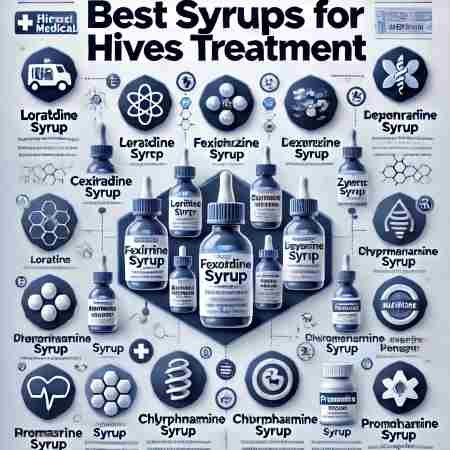
| Syrup Name | Details | Drowsiness | Usage |
|---|---|---|---|
| Loratadine Syrup (Claritin) | A non-drowsy antihistamine syrup is used to relieve itching, swelling, and discomfort from hives. | Non-drowsy | Daytime use |
| Cetirizine Syrup (Zyrtec) | Provides quick relief from hives symptoms such as itching and rashes; slightly sedative for some users. | Mild drowsiness | Daytime or nighttime use |
| Fexofenadine Syrup (Allegra) | A fast-acting syrup that helps relieve itching and swelling without causing drowsiness. | Non-drowsy | Daytime use |
| Levocetirizine Syrup (Xyzal) | An antihistamine syrup that helps treat hives and may cause mild drowsiness. | Mild drowsiness | Evening use |
| Diphenhydramine Syrup (Benadryl) | A strong antihistamine syrup that helps treat severe itching and allergic reactions; causes sleepiness. | Drowsy | Nighttime use |
| Desloratadine Syrup (Clarinex) | A prescription antihistamine syrup for treating chronic hives. | Non-drowsy | Doctor-prescribed for severe cases |
| Chlorpheniramine Syrup (Aller-Chlor) | Provides relief from itching and swelling but causes drowsiness. | Drowsy | Nighttime use |
| Hydroxyzine Syrup (Vistaril) | A potent antihistamine syrup for more severe allergic reactions and chronic hives. | Drowsy | Doctor-prescribed for severe hives |
| Promethazine Syrup (Phenergan) | A sedative antihistamine syrup that helps treat hives and severe allergic reactions. | Drowsy | Doctor-prescribed for severe cases |
| Clemastine Syrup (Tavist) | An antihistamine syrup that treats allergic symptoms like hives but may cause drowsiness. | Drowsy | Nighttime use |
| Montelukast Syrup (Singulair) | Helps reduce allergic reactions like hives and is often used in combination with antihistamines. | Non-drowsy | Doctor-prescribed for resistant hives |
Recommended Reading: Allergy Medicine Dogs: Best Allergy Medicine For Dogs Licking Paws
Best Injections For Hives Treatment
| Injection Name | Details | Usage | Prescription Required |
|---|---|---|---|
| Xolair (Omalizumab) | Used to treat chronic hives (Chronic Spontaneous Urticaria) in people over 12 years when other treatments don’t work. | Subcutaneous injection | Yes |
| Epinephrine Injection (EpiPen) | A fast-acting injection for severe allergic reactions, including hives and anaphylaxis. Used in emergency situations. | Emergency use | Yes |
| Prednisolone Injection | A corticosteroid injection that reduces inflammation and allergic reactions, including severe cases of hives. | Short-term treatment for severe hives | Yes |
| Diphenhydramine Injection | An injectable antihistamine for treating allergic reactions such as hives, particularly when oral medications aren’t effective. | For immediate allergic relief | Yes |
| Hydrocortisone Injection | A corticosteroid injection is used to reduce severe inflammation and allergic symptoms like hives. | Treats severe hives and inflammation | Yes |
| Cimetidine Injection | An H2 blocker injection that can be combined with antihistamines for severe hives. | Combination therapy for severe hives | Yes |
Best Creams For Hives Treatment
Best Creams
The best creams for hives treatment help soothe itching and reduce inflammation, offering quick relief from allergic skin reactions.
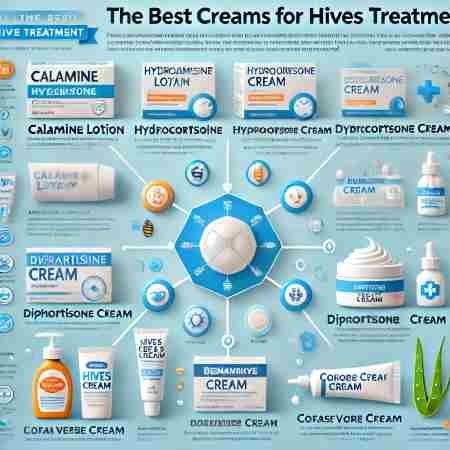
| Cream Name | Details | Usage | Prescription Required |
|---|---|---|---|
| Calamine Lotion | A soothing lotion that cools the skin and helps relieve itching caused by hives. | Apply to affected areas to reduce itching. | No |
| Hydrocortisone Cream | A corticosteroid cream is used to reduce inflammation, itching, and swelling from hives. | Apply to the skin to reduce itching and swelling. | No |
| Diphenhydramine Cream (Benadryl) | An antihistamine cream that helps relieve itching and swelling by blocking histamine in the skin. | Apply to the skin to reduce itching. | No |
| Prax Lotion (Pramoxine) | A cooling anti-itch cream containing menthol, providing relief from itching and irritation. | Apply to affected areas to soothe itching. | No |
| Cortisone Cream | A hydrocortisone-based cream that helps with inflammation and itching, and may contain aloe vera for soothing effects. | Apply to reduce inflammation and irritation. | No |
| Aloe Vera Gel | A natural soothing gel that can be used to cool and calm the skin, relieving discomfort from hives. | Apply gently on irritated skin. | No |
Best Creams For Hives Treatment
| Lotion Name | Details | Usage | Prescription Required |
|---|---|---|---|
| Calamine Lotion | A cooling lotion that soothes the skin and helps relieve itching from hives, especially those caused by heat. | Apply to itchy areas to reduce discomfort. | No |
| Hydrocortisone Cream | A steroid-based lotion that reduces swelling, redness, and itching from hives. Available in both OTC and prescription forms. | Apply to reduce inflammation and itching. | No (low dose), Yes (high dose) |
| Benadryl Cream (Diphenhydramine) | An antihistamine lotion that helps relieve itching and swelling by blocking histamine, which causes allergic reactions. | Apply to the skin to relieve itching. | No |
| Sarna Anti-Itch Lotion | A non-steroidal lotion that provides fast relief from itching with menthol and camphor. | Apply to irritated skin for itch relief. | No |
| Aveeno Anti-Itch Cream | Contains soothing ingredients like oatmeal to calm itching and irritation. Great for sensitive skin types. | Use on itchy, dry skin for relief. | No |
| Gold Bond Medicated Anti-Itch Lotion | A medicated lotion that provides cooling relief from itching and helps reduce inflammation. | Apply to affected areas to ease itching. | No |
| Vanicream Moisturizing Lotion | A gentle, fragrance-free lotion designed to relieve itching and restore moisture, ideal for sensitive skin. | Use to keep the skin moisturized and reduce itching. | No |
| Curél Hydrotherapy Itch Defense Lotion | A moisturizing lotion that helps to repair the skin barrier and provide relief from itchiness, especially when applied to wet skin. | Apply after a bath or shower for best results. | No |
| Prax Lotion (Pramoxine) | A menthol-based anti-itch lotion that provides cooling relief for hives and itching. | Apply to itchy areas for relief. | No |
Recommended Reading: Best Allergy Medicine For Cats: Types, Uses, & Side Effects
Home Remedies For Hives Treatment
Top Remedies For Hives Relief
Home remedies for hives treatment, like cold compresses and oatmeal baths, can provide relief by calming itching and reducing swelling naturally.
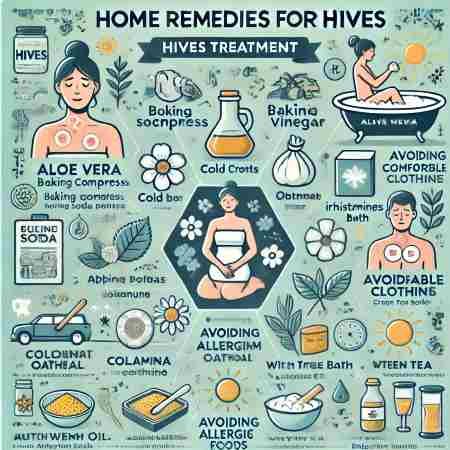
| Home Remedy | Details | How to Use |
|---|---|---|
| Aloe Vera | Aloe vera gel helps reduce itching and inflammation due to its soothing and cooling properties. | Apply a small amount to the affected area. |
| Cold Compress | Using a cool, damp cloth reduces itching and swelling by cooling the skin. | Apply a cold compress to the hives for 10-15 minutes. |
| Oatmeal Bath | Oatmeal helps calm irritated skin and reduces itching. | Add colloidal oatmeal to your bathwater. Soak for 15-20 minutes. |
| Baking Soda | Baking soda helps relieve itching and irritation. | Mix with water to make a paste and apply to the skin. |
| Apple Cider Vinegar | Known for its anti-inflammatory properties, apple cider vinegar can reduce itching and discomfort. | Dilute with water and apply gently to the hives. |
| Antihistamines | Over-the-counter antihistamines help block the histamine reaction causing hives. | Take oral antihistamines like Benadryl or Claritin. |
| Wear Comfortable Clothing | Loose clothing made from soft fabrics prevents further irritation on sensitive skin. | Wear breathable, loose-fitting clothes, preferably cotton. |
| Avoid Irritants | Staying away from known allergens or irritants helps prevent hives from worsening. | Identify and avoid triggers, like certain foods or chemicals. |
| Calamine Lotion | Calamine lotion soothes itching and irritation, providing relief for hives. | Apply a small amount to the affected area. |
| Coconut Oil | Coconut oil helps moisturize the skin and reduce itching due to its anti-inflammatory properties. | Apply a thin layer to the skin. |
| Colloidal Oatmeal | Colloidal oatmeal works to soothe itchy skin and reduce irritation. | Add to bathwater and soak for 15-20 minutes. |
| Tea Tree Oil | Tea tree oil has natural anti-inflammatory and antimicrobial properties that help calm skin. | Dilute with a carrier oil and apply gently to hives. |
| Turmeric Powder | Turmeric’s anti-inflammatory effects help reduce swelling and itching. | Mix with water to create a paste and apply to the skin. |
| Witch Hazel | Witch hazel acts as a natural astringent and helps soothe irritated skin. | Dab a small amount on the affected area. |
| Anti-Itch Bath | Taking a lukewarm bath with anti-itch ingredients like baking soda or colloidal oatmeal soothes itching. | Add anti-itch ingredients to the bath and soak. |
| Avoid Consuming Allergic Foods | Avoiding food allergens can prevent hives flare-ups. | Identify and eliminate allergy-causing foods from your diet. |
| Green Tea | Green tea contains antioxidants that can help reduce inflammation and support the body’s healing process. | Drink 1-2 cups of green tea daily. |
| Lukewarm Baths/Showers | Taking lukewarm baths or showers can calm the skin and reduce irritation. | Bathe in lukewarm water and avoid hot temperatures. |
| Relax | Stress can trigger hives, so relaxation techniques can help manage flare-ups. | Practice deep breathing, meditation, or gentle exercise. |
| Stay Cool | Heat can make hives worse, so staying in a cool environment helps reduce symptoms. | Stay in air-conditioned areas and avoid hot conditions. |
| Vitamin E | Vitamin E helps nourish the skin and reduce inflammation. | Apply Vitamin E oil to the skin for soothing relief. |
Natural Remedies For Hives Treatment
| Remedy | Details | How to Use |
|---|---|---|
| Tea Tree Oil | Tea tree oil has anti-inflammatory and antimicrobial properties, which can help calm skin and reduce hives. | Dilute with a carrier oil and gently apply to the affected areas. |
| Turmeric Powder | Turmeric is known for its powerful anti-inflammatory effects, which can reduce swelling and itching caused by hives. | Mix turmeric powder with water to make a paste and apply it directly to the skin. |
| Green Tea | Green tea contains antioxidants that help reduce inflammation and support healing. | Drink 1-2 cups of green tea daily to promote healing from within. |
| Avoid Consuming Allergic Foods | Identifying and avoiding food allergens can prevent hives from occurring or worsening. | Remove known allergy-causing foods from your diet to avoid flare-ups. |
| Lukewarm Baths/Showers | Lukewarm water can soothe irritated skin and help reduce itching caused by hives. | Take a lukewarm bath or shower and avoid hot water to prevent further irritation. |
| Relaxation Techniques | Stress can trigger hives, so relaxation practices can help manage and prevent outbreaks. | Engage in deep breathing exercises, meditation, or yoga to reduce stress levels. |
Recommended Reading: Anti Allergy Medicine For Skin Itching (Uses & Side Effects)
Home Remedies for Hives Treatment
| Home Remedy | Details |
|---|---|
| Cold Compress | Apply a cool damp cloth or ice pack to the affected area to help reduce swelling and itching. |
| Oatmeal Bath | Soaking in a lukewarm bath with colloidal oatmeal can soothe irritated skin and reduce itching. |
| Antihistamines | Use over-the-counter antihistamines like diphenhydramine (Benadryl) to help relieve itching. |
| Apple Cider Vinegar | Mix equal parts of apple cider vinegar and water, then apply to the hives with a cotton ball to soothe the skin. |
| Baking Soda Paste | Create a baking soda paste with water and apply to the hives to help calm the itching. |
| Calamine Lotion | Applying calamine lotion can give immediate relief from the itching and discomfort caused by hives. |
| Wear Comfortable Clothing | Wear loose-fitting, breathable cotton clothes to avoid further irritation. |
| Anti-Itch Creams | Apply anti-itch creams or lotions, like those containing menthol or hydrocortisone, to soothe the affected area. |
| Avoid Irritants | Stay away from known triggers or irritants, like certain foods or chemicals, to prevent hives flare-ups. |
| Moisturize | Use fragrance-free moisturizers to keep your skin hydrated and prevent dryness that can worsen the condition. |
| Coconut Oil | Apply coconut oil to the affected skin to help reduce inflammation and relieve itching. |
| Avoid Scratching | Avoid scratching the hives, as it can worsen the irritation and delay healing. |
| Cool Baths/Showers | Taking a lukewarm or cool bath helps relieve itching and soothes irritated skin. |
| Turmeric Powder | Turmeric’s anti-inflammatory properties may help reduce redness and inflammation when applied topically or consumed. |
| Witch-Hazel | Applying witch hazel can help soothe the skin due to its astringent and anti-inflammatory properties. |
| Stress Management | Practice stress-reducing activities like yoga or meditation to prevent stress-induced hives. |
| Supplements | Taking vitamin C, B-12, and D supplements may help improve the body’s response to allergens and reduce hives. |
Recommended Reading: Food Allergy Treatment At Home (Causes, Symptoms, And Treatment)
Hives Allergy Causes, Symptoms, Side Effects, And Diagnosis
Diagnosis Methods For Hives Allergy
Diagnosis methods for hives allergy include skin and blood tests to identify allergens triggering the reaction.
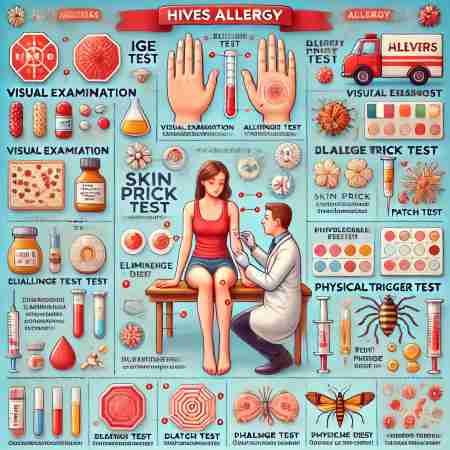
Diagnosis Methods For Hives Allergy
- Visual Examination: The doctor will examine the raised, red, and itchy welts on your skin to confirm they resemble typical hives.
- Medical History: Your doctor will ask detailed questions about recent exposure to potential allergens like foods, medications, insect bites, or changes in your environment.
- Skin Prick Test: This test involves applying small amounts of allergens to the skin and then pricking it to observe if there’s a reaction, helping identify specific triggers.
- Blood Test (IgE Test): A blood test measures IgE antibodies to detect allergies to specific substances that may be causing your hives.
- Elimination Diet: The doctor may recommend removing certain foods from your diet to see if the hives improve, helping to pinpoint food-related triggers.
- Challenge Test: In some cases, you may be exposed to suspected allergens under medical supervision to observe if they cause hives or allergic reactions.
- Patch Test: For possible contact allergens, small patches with allergens are applied to your skin to check for delayed reactions.
- Physical Trigger Test: If your hives are caused by temperature changes, exercise, or pressure, the doctor might expose you to these triggers and observe any reactions.
- Thorough Allergy Testing: If common tests are inconclusive, the doctor might recommend comprehensive allergy panels to check for a wide range of possible allergens.
- Family History: Your doctor may inquire about any family history of allergies or autoimmune conditions that might increase your likelihood of hives.
- Chronic Urticaria Evaluation: If the hives persist for a long time, the doctor may investigate for chronic urticaria, which requires a more detailed diagnostic approach.
- Referral to an Allergist: In complicated cases, you might be referred to a specialist allergist for further testing and evaluation.
Causes of Hives
- Food Allergies: Common triggers include nuts, eggs, shellfish, and dairy products.
- Medications: Antibiotics, aspirin, and ibuprofen can cause hives in some people.
- Insect Bites or Stings: The venom from insects can trigger a hive outbreak.
- Stress: Emotional stress can sometimes cause hives or make them worse.
- Temperature Changes: Extreme heat or cold can cause hives to appear.
- Infections: Viral or bacterial infections, like a cold or flu, may lead to hives.
- Pollen: Exposure to pollen can cause allergic reactions resulting in hives.
- Pet Dander: Allergies to animals like cats or dogs can trigger hives.
- Sun Exposure: Some people develop hives after being in the sun for a while.
- Exercise: Physical activity can sometimes lead to hives, especially when combined with heat.
- Tight Clothing: Wearing tight clothes or accessories can cause irritation and lead to hives.
Recommended Reading: Best Allergy Medicine For Dogs Licking Paws
Symptoms of Hives
- Itchy Skin: One of the most noticeable symptoms is severe itching.
- Red or Skin-Colored Welts: These raised areas may be red or match your skin tone.
- Swelling: Swelling can occur around the affected areas, particularly the eyes, lips, or throat.
- Burning Sensation: Some hives may feel hot or give a burning sensation.
- Varying Size: The welts can be small or large and can change in size over time.
- Clustered Patches: Hives may appear as small spots or merge into large patches.
- Fading Welts: The welts can appear suddenly and fade within a few hours.
- Relocation: New welts may form as old ones fade, often moving around the body.
- Tenderness: Some hives can feel tender to the touch.
- Worsening with Scratching: Scratching can make the itching and swelling worse.
- Triggered by Pressure: Hives might appear or worsen when pressure is applied to the skin.
Side Effects of Hives
- Itching: The most common symptom of hives is severe itching, which can be irritating and affect daily activities.
- Red Welts: Raised, red, or skin-colored welts that can vary in size and appear anywhere on the body.
- Swelling: Areas around the hives can swell, especially on the face, lips, or around the eyes.
- Burning Sensation: Some individuals may feel a burning or stinging sensation in the affected areas.
- Pain: In some cases, hives can be painful, particularly when they cover large areas of the skin.
- Skin Sensitivity: The skin may become extra sensitive, causing discomfort when touched or exposed to friction.
- Fatigue: Persistent itching and discomfort may lead to trouble sleeping, causing tiredness or fatigue.
- Breathing Issues: In severe cases, hives may cause swelling in the throat, leading to difficulty breathing.
- Dizziness: Severe allergic reactions that cause hives may sometimes lead to dizziness or lightheadedness.
- Joint Swelling: In some cases, hives can lead to swelling in joints, causing discomfort or stiffness.
- Emotional Stress: The discomfort and visibility of hives can lead to anxiety, embarrassment, or emotional distress.
Benefits Of Hives Treatment Medicines
- Relieves Itching: Hive medicines help reduce the intense itching that often accompanies this condition, providing immediate comfort.
- Reduces Redness: These treatments can reduce the redness and swelling on the skin, making it look and feel better.
- Speeds Up Recovery: Certain medicines work quickly to clear up hives, helping you recover faster.
- Prevents New Hives: Some treatments not only treat existing hives but also help prevent new ones from forming.
- Eases Swelling: Medicines can help reduce the swelling in areas affected by hives, especially on the face and throat.
- Improves Sleep: By controlling the itching and discomfort, hives medications can help you sleep better without interruptions.
- Reduces Pain: For those experiencing pain with hives, treatment can help ease this discomfort.
- Prevents Complications: Early treatment of hives can prevent severe allergic reactions, such as difficulty breathing, which requires emergency care.
- Boosts Confidence: With the redness and swelling reduced, you may feel more confident about your appearance.
- Supports Daily Activities: Treating hives allows you to carry on with daily tasks without being distracted by itching or discomfort.
- Safe and Effective: Most hives treatment medicines are safe and have been proven effective when used as directed by a doctor.
Recommended Reading: Best Allergy Medicine For Kids
FAQs
What are hives?
Hives are red, itchy bumps on the skin that appear suddenly. They are often caused by allergic reactions, stress, or environmental triggers.
What causes hives?
Hives are usually triggered by allergens such as certain foods, medications, insect bites, stress, or exposure to extreme temperatures.
How can antihistamines help with hives?
Antihistamines block histamine, a chemical in the body that causes allergic reactions like hives. By blocking histamine, they help reduce itching, redness, and swelling.
What are the common over-the-counter antihistamines for hives?
Popular over-the-counter antihistamines include Benadryl (diphenhydramine), Claritin (loratadine), Zyrtec (cetirizine), and Allegra (fexofenadine).
Are there any side effects of taking antihistamines?
Common side effects include drowsiness (especially with Benadryl), dry mouth, dizziness, and fatigue. Non-drowsy options like Claritin or Allegra may have fewer side effects.
What are the best treatments for hives?
The primary treatment for hives is antihistamines. Cold compresses and avoiding triggers like heat or certain medications can also help. If the hives are severe or chronic, other treatments like corticosteroids or immunosuppressants.
How can I treat hives at home?
You can treat hives at home by applying cool compresses, taking a cool bath, wearing loose-fitting clothing, and using anti-itch creams. Over-the-counter antihistamines like Benadryl can also help relieve symptoms.
Can natural remedies help with hives?
Yes, natural remedies like oatmeal baths, aloe vera, and baking soda can help soothe hives. Cold compresses and calamine lotion are also effective for relieving itching and irritation.
Can stress cause hives?
Yes, stress can trigger or worsen hives in some people. Managing stress through relaxation techniques, exercise, or meditation may help prevent flare-ups.
Can hives be treated with injections?
Yes, in severe cases, injections like omalizumab (Xolair) or corticosteroids may be used to treat chronic hives. Epinephrine (EpiPen) is used for emergencies like severe allergic reactions.
Conclusion
Recommended Reading: Anti Allergy Medicine For Skin Itching (Uses & Side Effects)
In conclusion, over-the-counter antihistamines are a common and effective way to treat hives caused by allergic reactions. These medications, such as Claritin, Zyrtec, and Benadryl, help reduce itching, swelling, and other symptoms by blocking histamines in the body.
Along with antihistamines, other remedies like cold compresses and soothing lotions can provide relief. It’s important to avoid triggers like certain foods, medications, or environmental factors that can cause hives.
However, if symptoms persist or worsen, especially if breathing difficulties occur, consulting a doctor is crucial. Managing hives is all about finding the right treatment and prevention methods for your specific triggers.
Disclaimer
Commissions we earn from partner links on this page do not influence our content. Our editorial content is based on thorough research and insights from qualified medical professionals to ensure the highest standards of accuracy and reliability.
Information provided on Doseway is for educational purposes only. Your health and wellness are unique to you, and the products and services we review may not be suitable for your circumstances. We do not offer personal medical advice, diagnosis, or treatment plans. For specific advice, please consult with a healthcare professional. Doseway adheres to strict editorial integrity standards. To the best of our knowledge, all content is accurate as of the date posted, though offers and information may change. The opinions expressed are the author’s own and have not been influenced, approved, or endorsed by our partners.

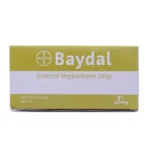
Add a Comment